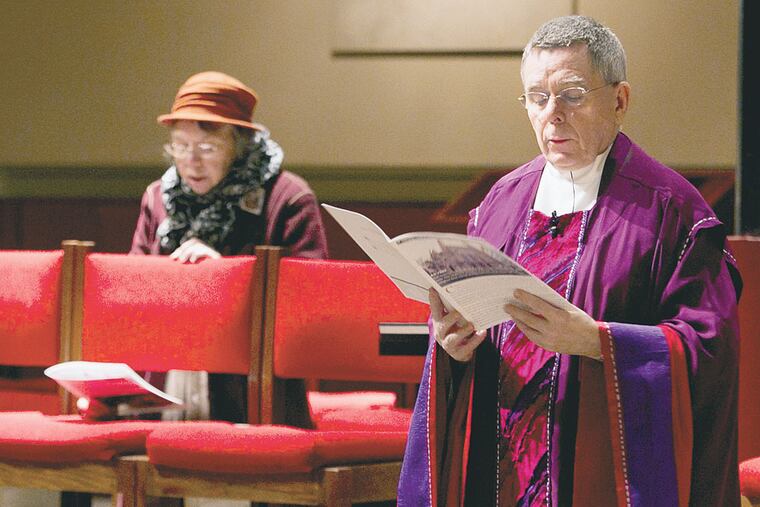Healing, then and now
World famous in the '50s, St. Stephen's is now soothing spirits with less fanfare.

IN THE 1950s and into the early 1970s, St. Stephen's Church was the site of a world-renowned healing ministry. The ailing came from far and wide to pray with the church's leader, the Rev. Dr. Alfred Price. Those who were unable to travel could ask St. Stephen's 135-member prayer group, which prayed in shifts 24 hours a day, to include their names in their appeals.
In a 1971 article, the Reading Eagle wrote that "through prayer and the proper medical assistance, [Price] has seen man cured of everything from colds to cancer, arthritis to alcoholism, and ear ache to epilepsy."
"There is no such thing as an incurable disease," Price said then. (He passed away in 1992.) "There is only an incurable person."
The focus at St. Stephen's today is more on spiritual renewal and healing. Services include meditation and chanting, allowing people to lose themselves in individual prayer. Although nominally an Episcopal church, it draws worshippers from many different Christian faith traditions.
"It's really a church for all people," said the Rev. Dr. Charles Flood, the current rector, who has helmed St. Stephen's for 22 years. "A lot of people come in and pray and leave renewed, with or without a [formal] service."
Where we worship: St. Stephen's is at 19 S. 10th St., just below Market Street. There are two weekly services: Thursdays at noon and 10 a.m. Sundays. Additional services are held for Christmas Eve - this year at 9 p.m. - and other holidays.
Architect William Strickland designed the church in Gothic style, making St. Stephen's one of the country's first such structures - it was built in 1823 - and igniting a Gothic Revival craze in the U.S.
In 1878, Victorian architect Frank Furness designed the parish house. Some of the interior touches, including some windows and marble furnishings, were done by the Tiffany Co.
Open the doors, see the people: In addition to regulars from its congregation, the Center City church also attracts drop-in medical staff from nearby Thomas Jefferson University Hospital. Out-of-town visitors to the Pennsylvania Convention Center also step inside for spiritual healing.
What we believe: Flood said the Episcopal church makes a point of welcoming others under its "big tent."
"All are welcome," he said.
Arts patrons, included: The Lantern Theater Company is one of two arts organizations housed at St. Stephen's. It has its offices there and uses the church's theater for performances.
Philadelphia Sinfonia, a youth orchestra, performs and practices in the sanctuary. "There's a very spiritual side to the arts," Flood said. "They affect the soul."
Fabric for thought: St. Stephen's has a canvas labyrinth that is sometimes set up inside the church, allowing for a sort of walking prayer. "It's a great meditation device," Flood said.
(The concept was developed by a California priest in 1994. Her organization, at www.veriditas.net, provides details on the practice.)
St. Stephen's takes out its labyrinth when groups request it. Once, Flood said, a 20-something young man came into the church in street clothes, changed in the bathroom into a long off-white robe and began to walk the labyrinth. In the middle, he performed some yoga poses. Then he changed back into street clothes, and left.
Something that might surprise people: On Ash Wednesday, the faithful don't need to attend services to express their piety. St. Stephen's offers an "Ashes To Go" program. Last year, Flood stood outside the church all morning, applying ashes to about 300 foreheads. "People lined up down the street," he said. "This was the perfect thing for our particular parish."
Big moral issue we're grappling with: The increasing gap between rich and poor. "Worldwide poverty is a big moral issue," Flood said.
"The church isn't in the position to write checks and say, 'This will solve all the problems.' Our role is to help people understand that this country is still a very wealthy place and there are people who are starving in our midst."
Sharing strength: In addition to his work in Philadelphia, Flood has served as a spiritual counselor to the New York City Medical Examiner's Office since 9/11. He works mostly with first responders but also with a few families who lost loved ones.
Each year, he leads the morgue's memorial service, praying for 9/11 survivors and the many victims whose remains are still not identified.
Words of hope: No matter how bleak things seem, God is always there, Flood said. "His love is what created this world and it's what sustains us. People should remember that.
"We can't change the course of our lives - we get sick or we may suffer some tragedy - but we're not alone in the universe."